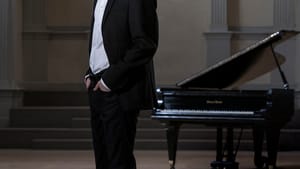Stay in the Loop
BSR publishes on a weekly schedule, with an email newsletter every Wednesday and Thursday morning. There’s no paywall, and subscribing is always free.
Piano perfection
PCMS presents pianist Juho Pohjonen

In few other performance formats does a musician’s artistic attainment stand out stark and clear as in the solo piano recital. Regardless of the program, every aspect of the performer’s artistry, from technical facility to the communication of the most profound ideas and sensations, shines naked and alone. Every crack in the pianist’s armor will be exposed. No matter how well prepared, the artist’s fingers cannot go on autopilot. Every solo musician takes the concert stage with an entire career on the line; the audience expects nothing short of perfection. And perfection is what young Finnish pianist Juho Pohjonen delivered for PCMS at PAFA’s new Rhoden Arts Center on October 27.
Most Americans know Finland for Sibelius, marinated herring, and President Niinistö’s recent encounter with Donald Trump. The musical luminaries of southern Scandinavia are less well-known on this side of the pond. All that may change, at least locally, thanks to the innovative programming and derring-do of PCMS.
Rameau meets the piano
Pohjonen presented a fascinating program of unexpected pairings. The first half of the concert was dedicated to the third book of Pièces de Clavecin (keyboard pieces) by Jean-Philippe Rameau (1683-1764), master of the late French Baroque. Pièces is a collection of rococo dances and other short works, usually played on the harpsichord, from 1727. Included among these pieces are the familiar La Poule (the hen) and Les Sauvages (the savages, which we now know is a false and racist moniker), inspired by a Native American performance that Rameau saw in 1725. A number of the selections have titles of dance forms familiar to Bach enthusiasts (allemande, courante, sarabande).
Over the course of 45 minutes, Pohjonen performed the 15 selections with only a short pause between, treating each work as a sparkling, unique entity worthy of his complete absorption and attention. For listeners used to hearing this work performed, perhaps mechanically, on the harpsichord, with its flat dynamics and sometimes shrill timbre, the pianist’s performance was truly a revelation, exploring a wealth of innuendos and broad vistas with tonal coloring that was at once intelligent and full of feeling.
Rameau’s music is spangled with trills and other late Baroque ornaments, often designed to give the impression of the sustained tones which cannot be achieved on the harpsichord. Pohjonen has transformed these frills into solid musical elements: they can be light and feathery, or strong and commanding, depending on his interpretation of a passage or an entire piece. The breadth and maturity of his vision made this assortment of musical bonbons something truly extraordinary and not the French-court fluff we may commonly expect to hear.
Serving Scriabin
The second half of the program was dedicated to a composer who couldn’t be more artistically different than the rococo master. Alexander Scriabin (1871-1915) was born in Moscow on Christmas Day and died during Eastertide, befitting an artist whose musical life was a mystical quest involving synesthesia (in his case, associating tones with visual colors), a signature mystic chord, and the blending of music with the visual arts. Listening to these three sonatas—Nos. 6, 8, and 10—we are struck by how modern this composer sounds in the context of his time, or even today, remembering that he died just two years after the premiere of Stravinsky’s Rite of Spring and pioneered the creation of tone rows before Schoenberg.
One of the first things notable about Pohjonen’s approach was the different way he held his hands over the keyboard as he launched into Sonata No. 6 Op. 62. Unlike the purposeful arc of his fingers in the Rameau, for Scriabin his right hand was flat, almost concave on the keys, foretelling a completely different point of departure. With as many ornamental flourishes as anything by Rameau, the music swelled from the Steinway almost organically, like a time-lapse photograph of leaves that explode from a few tendrils into a tangle of forest vines.
A miracle of virtuosity
The three works were played without interruption, and though sometimes it was difficult for those unfamiliar with the scores to know exactly where the artist was taking them, the mood of introspection, exploration, and serendipitous discovery was captivating. Scriabin’s sonatas are demanding on both artist and audience, but transport us to another world of sensation and expectation. Pohjonen’s performance was a miracle of virtuosity, offering an intelligent interpretation, a kind of pulling together of the tone patches, shapes, and colors Scriabin provides, whether or not one cares to consider the composer’s explanation of the basis of his work. In Pohjonen’s hands, the gifts of both Rameau and Scriabin are pure art.
What, When, Where
The Philadelphia Chamber Music Society presents pianist Juho Pohjonen. Jean-Philippe Rameau, Les Nouvelles suites de Pièces de Clavecin; Alexander Scriabin, Piano Sonata No. 6 Op. 62, Piano Sonata No. 8 Op. 66, and Piano Sonata No. 10 Op. 70. October 27, 2019 at the Rhoden Arts Center of the Pennsylvania Academy of the Fine Arts, 128 N. Broad St., Philadelphia. (215) 569-8080 or www.pcmsconcerts.org.
PAFA is an ADA-compliant venue. Wheelchairs are available free of charge to patrons who need them. PCMS performs in a variety of venues around the city. Patrons with specific questions about accessibility can call PCMS or email [email protected].
Sign up for our newsletter
All of the week's new articles, all in one place. Sign up for the free weekly BSR newsletters, and don't miss a conversation.

 Linda Holt
Linda Holt